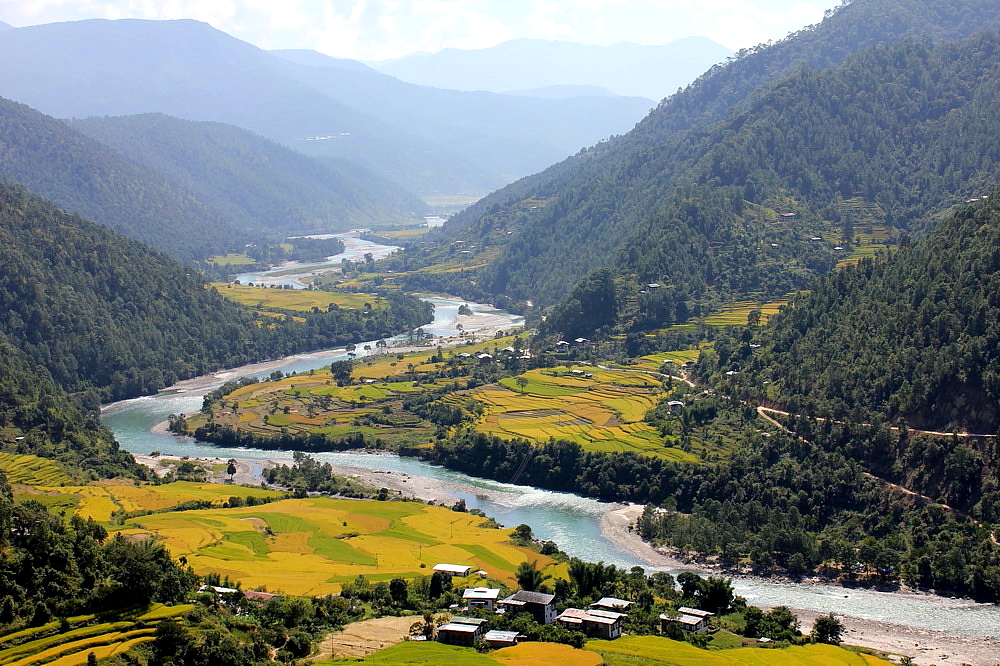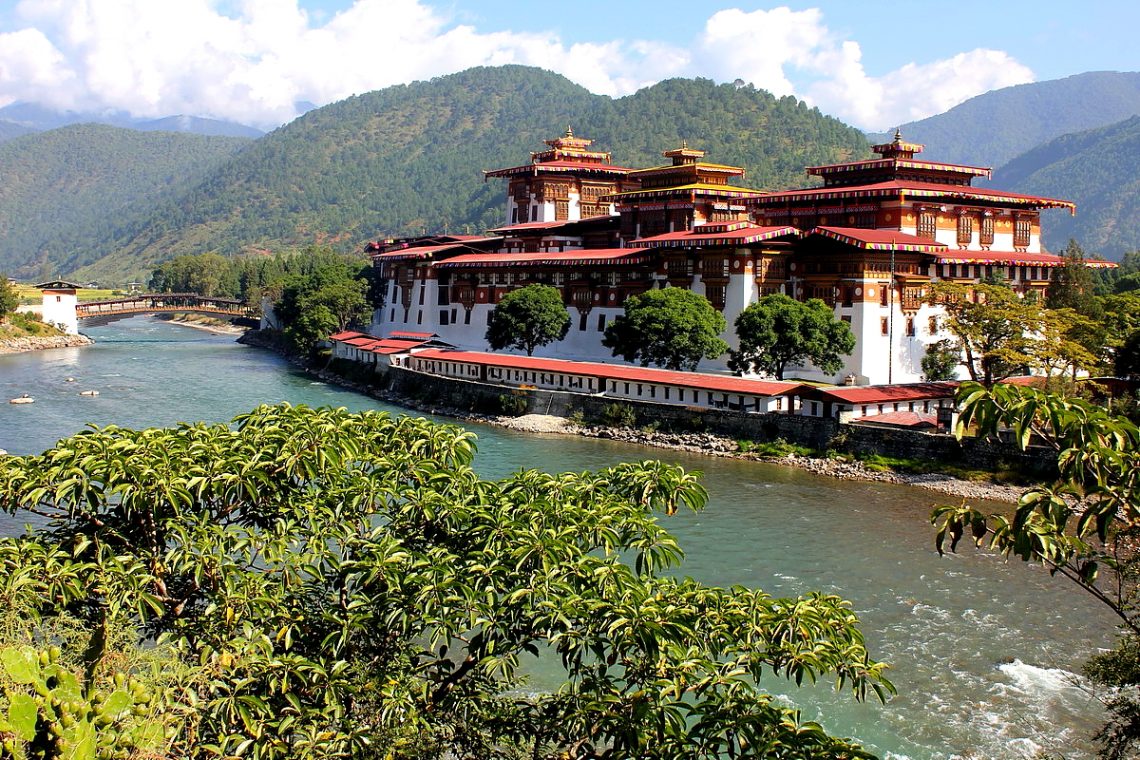Bhutan would be an interesting place even if you didn’t spent a minute there.
Which other country measures Gross National Happiness instead of GDP? Where is the king himself the biggest democrat? Who protects their traditions and natural environment as much as the Bhutanese? After the first part of my article, let’s take a look at what you can see if you travel there.
One of the world’s most dangerous landings
The very first surprise met me at Kathmandu airport where, in the duty free shop, I discovered to my surprise some Hungarian Tibi chocolate on offer. I had plenty of time to marvel at it, as our flight from Nepal to Bhutan was delayed due to the cloudy weather. Thimpu Airport is listed among the world’s most dangerous airports. It’s only possible to land there under excellent visibility, so we had to wait for the good weather to appear. Luckily we only had to kill time in the lounge until dawn, when we could finally board the plane.
Before my trip I read everything I could about this flight. Apparently it’s almost impossible to spot Mount Everest from the window of the plane, but just in case you happen to catch a perfectly clear day, you should sit on the left of the plane. Needless to say, all the seats were sold out here, but after boarding was completed, I noticed that nobody was sitting in the back row, so in no time, faster than the speed of light I was there. I took the window seat on the left, and my camera clicked away without a stop. In the undisturbed sunlight many wonderful photos were taken.
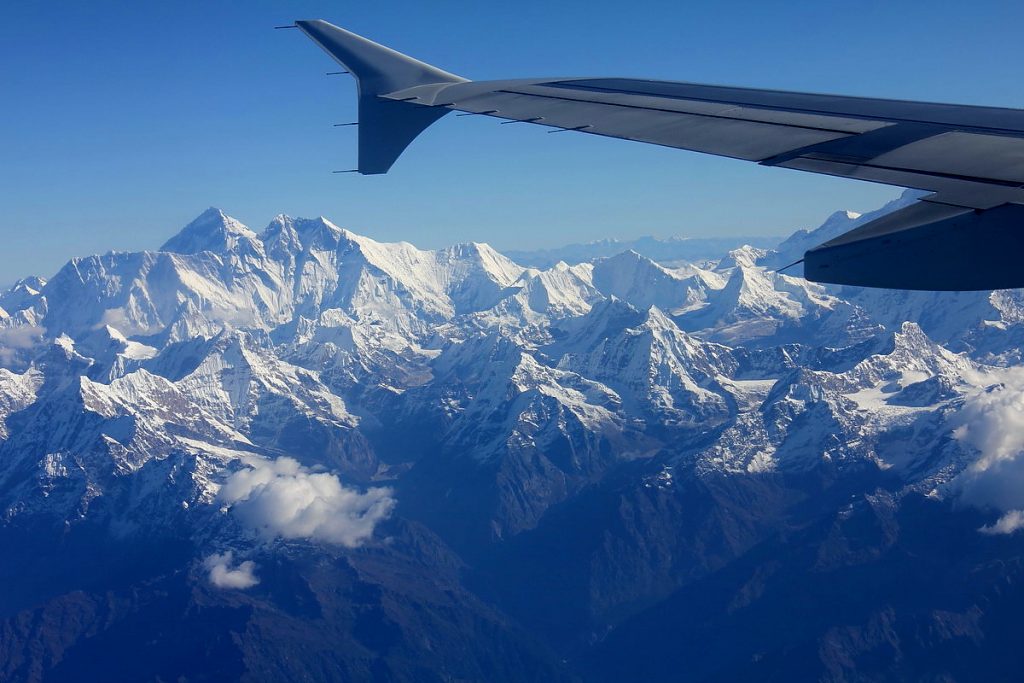
Upon landing, something unprecedented happened, which I haven’t experienced at any other airport before. People were not rushing around, treading on each others’ feet to run through passport control. Instead they were wandering by the plane with eyes wide open, trying to embrace the view: a sun-kissed valley hidden among enormous mountains, with the colorfully painted airport buildings and the billboards of the 5 previous and present kings.
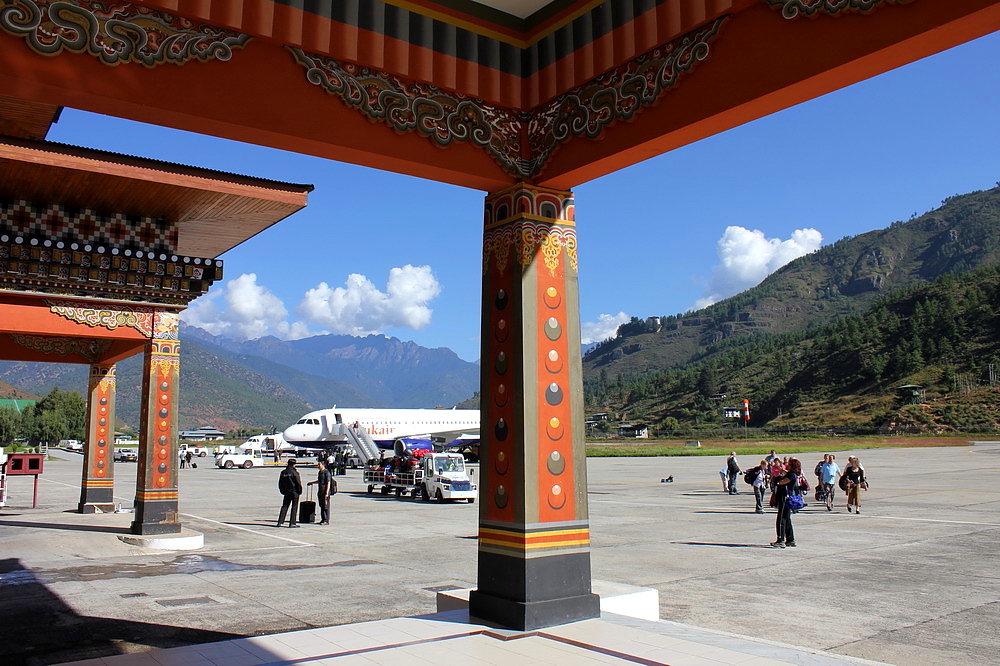
We rode a bus to our first accommodation, where we had lunch straightaway, buffet style. This was the style later too, because in Bhutan there are only a few restaurants. Locals prefer to eat at home and the tourists are served by hotels. Meat is rare and tough, a typical side dish is red rice (red only in its name, it’s rather pink), and steamed vegetables are extremely tasty.
Right after lunch we started our first trek. Our goal was Cheri Dorji Dhen Monastery, built in 1620 and called Cheri Goemba by the locals. There was an hour-long steep climb, then the same in descent. We walked through some villages along the way and were astonished by the houses with carved-painted windows. On the walls of some of the houses were huge painted phalluses, which are meant to keep the devil away.
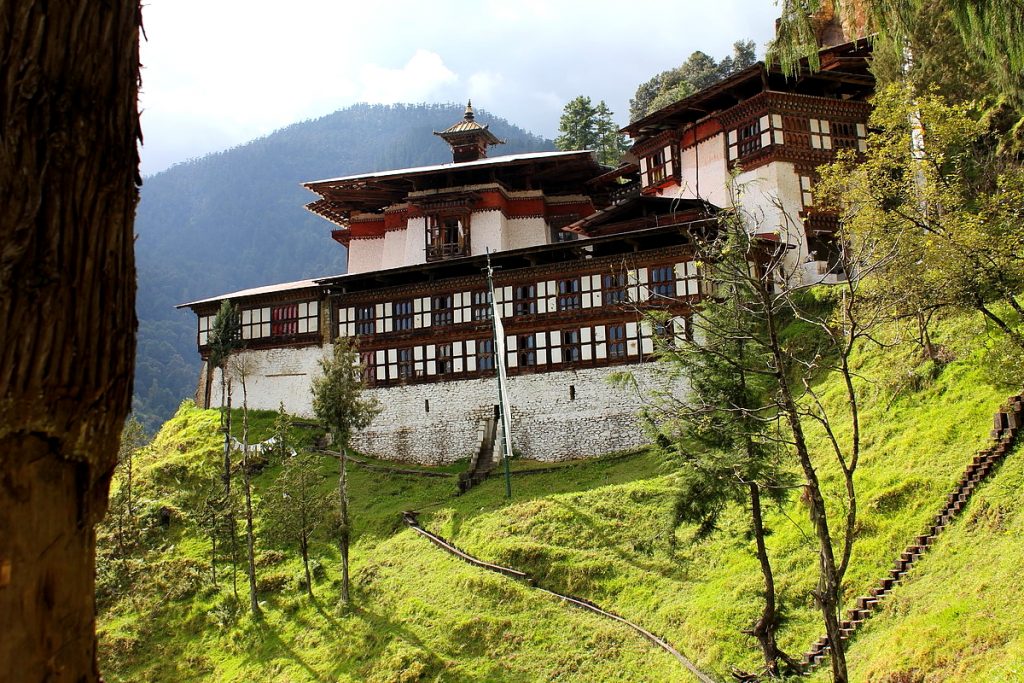
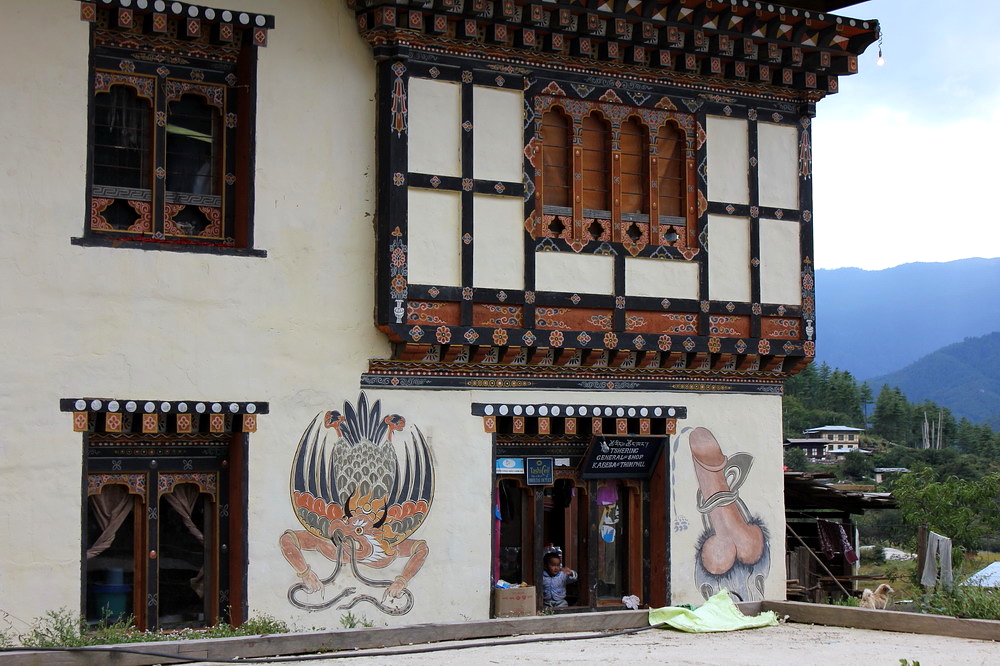
Connection with the saints
In Bhutan there are about 2000 monasteries, most of which hold an annual festival. The most remarkable one is in the capital, the Thimpu festival which lasts for three days. This was the highlight of our trip. It is always held in autumn, at the end of September or beginning of October (depending on the lunar calendar, from the 10th day of the 8th month).
Another big event is the Paro festival in April. Most tourists visit Bhutan during these two festivals, especially as spring and autumn are the most favorable seasons for travelling here. The monastery is breathtakingly beautiful even without the festival – given its location and the building itself – but with a few thousand locals dressed up, it is extraordinarily amazing.
During festivals, dancing will take place in the courtyards of the monasteries. There are two kinds of dancing: a sacred dance performed in masks by monks, plus the folk dances of local groups.
The festivals are always held in honor of Guru Rinpoche. While watching the dances, the visitors receive Buddha’s blessing – the more dancing, the bigger the blessing. According to the Bhutanese’s faith, dances activate the relationship between humans and saints, this way they help take a look at Buddha’s teachings. Some of the dances depict sacred lectures, others are of moral or historical content. There are also ones with a soul cleansing effect, that ostracize demons and there are others that show the way to enlightenment.
Locals attend the festivals exclusively in their traditional clothes, although they mostly wear these anyway. Men wear long tunics, in the past with embroidered boots and swords too, but these days they are rarely seen. Women dress up in gowns that touch the ground and a short little jacket, always in wonderful colors. For the big event, everyone wears their best clothes and many have new ones just for the occasion. Youngsters try to look trendy of course, and show off mainly with their footwear. Boys wear eye-catching trainers, while girls put on high heeled sandals, and sometimes strong make up as well.
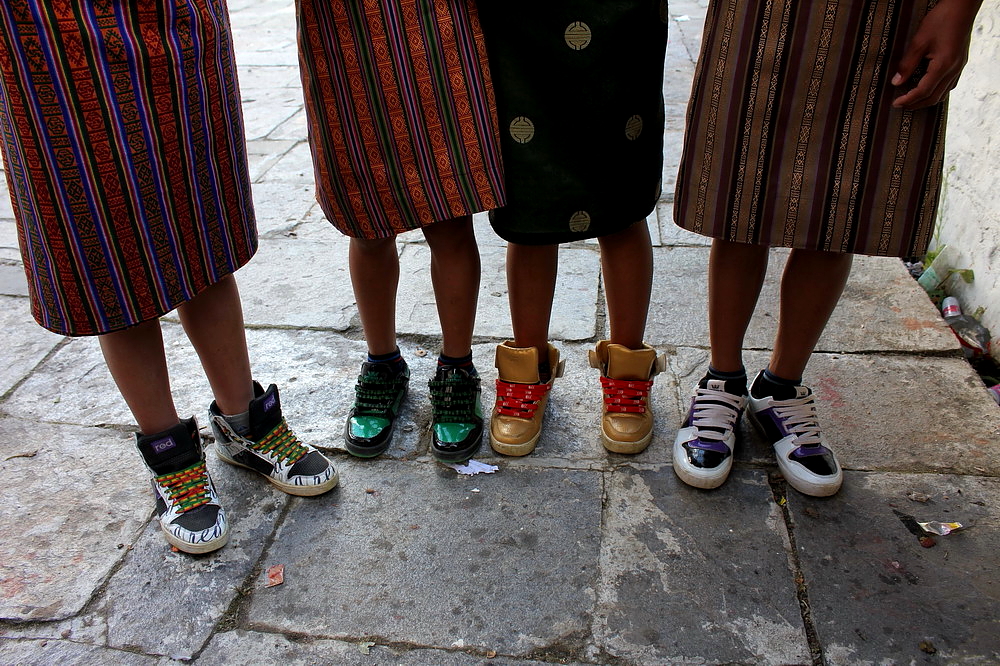
A few dozen policemen and volunteers secured the order, their task was exclusively to guide human traffic. Our guide, Phim, warned us before departure to take care of our belongings. Of course we will we told him – huge crowds are always dangerous, there are thieves everywhere. Phim didn’t seem to understand our response. “Thieves?” He asked, raising his eyebrows. “But no one steals here! Just watch out, because when you drop something, you may not find it in the hustle and bustle!”
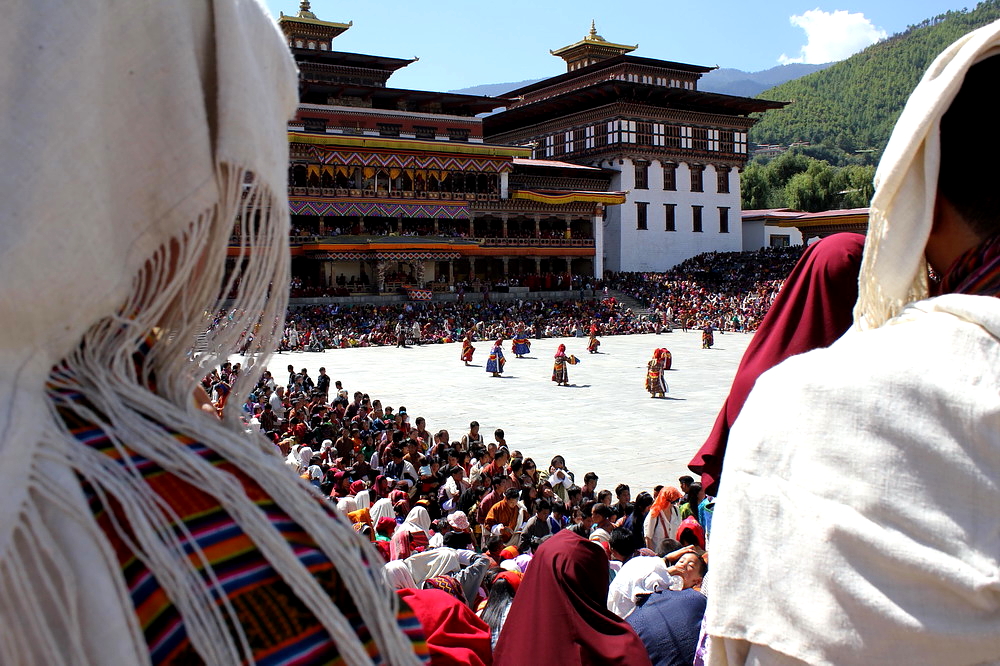
A country with no traffic lights
After attending the festival, we discovered the capital. Thimpu is the only capital in the world where there are no traffic lights, not even today. Ten years ago, one was erected in the one and only, so-called busy crossroads in Thimpu. However, people couldn’t get used to it, so a few days later it was dismantled. Since then police have guided traffic again.

Another even stranger story is that of the zoo. A few years ago a zoo was founded in the capital, with all kinds of exotic species. But after a while it was apparent that the animals didn’t grow as big as their relatives in the wild, and they didn’t breed as many off-springs either. When the king became aware of this, he figured that the animals were obviously unhappy. Therefore, he ordered that each one of them be returned to their natural habitat. Only the country’s national animal, the takin, would stay and now the zoo operates as a takin reserve.
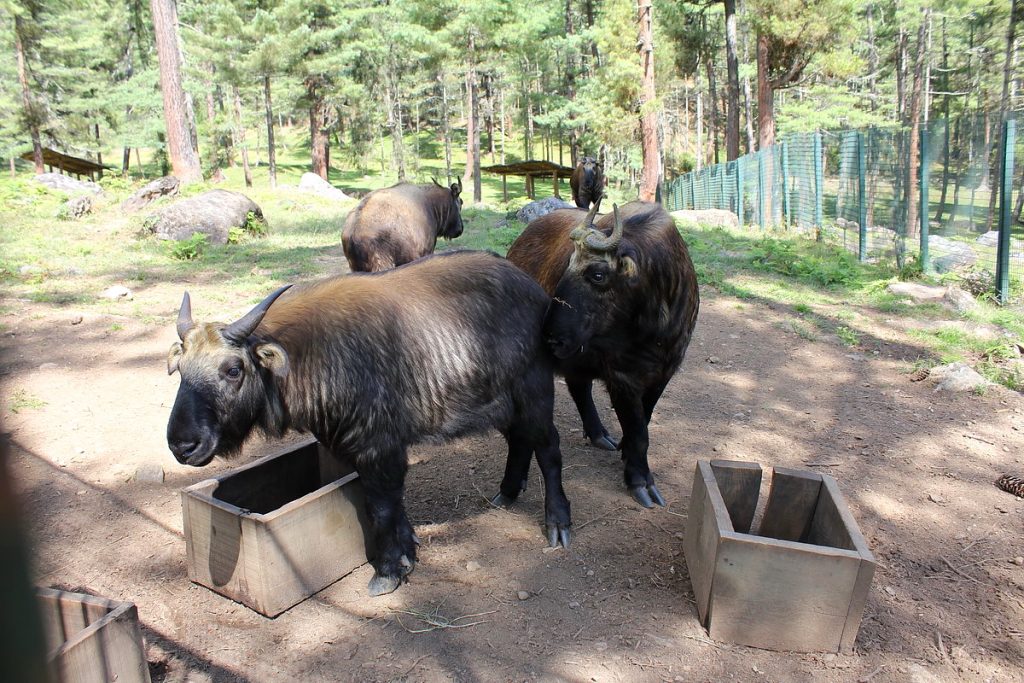
Local legend says the takin was created by Lama Drukpa Kuenley, using the body of a cow and the head of a goat . The ‘Crazy Saint’ who lived between 1455 and 1520 is one of the most beloved saints of Tibetan Buddhism, and was famous for his wonderful deeds and for spreading sexual freedom.
Where only a handful of tourists go
Leaving the capital we headed East. We drove along road no 2, completed in 1971, towards the middle of the country, which used to be reachable only on foot or by horse. The first 175 km long road, built in 1962, connected the capital with India, reducing the 6-day-long journey to just 6 hours. There is still no railway.
This part of Bhutan is visited by only a few tourists. As there is a compulsory 250 US Dollar daily fee, the vast majority of two-week package holidays spend only 4-5 days in Bhutan (mainly around Thimpu and Paro), filling the remaining time with another country (eg. combining Bhutan with Nepal or India). We, on the other hand, travelled for two whole weeks in Bhutan, so we found the time to explore some of the more hidden parts as well.
While heading East, we reached Dochula pass (3140 meters), where there are 108 small chortens (Buddhist monuments) in the company of numerous prayer flags.
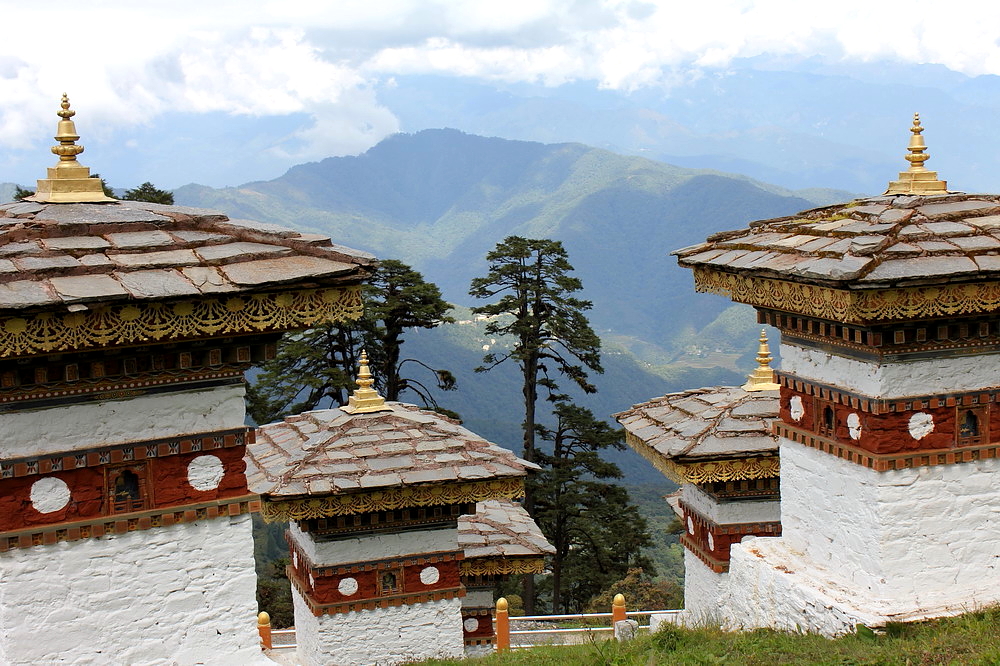
We also paid a visit to the Ducha Kunley Temple. Many childless women make a pilgrimage there in the hope of future children. A monk blessed us, touching our heads with three sacred objects. This was a rather special trio: a bow, an elephant tusk and a phallus carved out of wood.
It was a pleasant surprise to see an archery competition along the way. Archery is the most popular sport in Bhutan. Men often go to the edge of their village to practice, strictly dressed in traditional clothes, and also bringing some booze with them.
The next day we were hiking again. Only the beginning section was tough, the climb to Khamsun Yuelley Namgyal Chorten, but because of the view it was well worth it.
After ambling down the mountain, we walked by the river and saw golden rice fields, a winding blue river, and lush green mountains in every direction. At the end of the road, we reached one of the King’s residences, which is a surprisingly modest structure.

In the evening I caught our Guide secretly smoking a cigarette behind the building. In Bhutan it is forbidden to smoke in public places and it is illegal to sell cigarettes. If someone wants to smoke, they have to import their cigarettes from India and pay 100% customs tax. If anyone is caught smoking in public, Inspectors will ask for the relevant customs papers – if they have them, the person only has to pay a heavy fine, but if the documents are missing, they risk a sentence of up three years in prison.
We went further East towards Tongsa. We travelled only 150 kilometers in total, but it took us 6 hours. The theoretical two lanes were in fact only one and a half, so driving next to the gorges was not for the faint-hearted.
After arriving in Tongsa, we immediately headed to a fortress at a dramatic location. A large crowd attended a celebration there. The Bhutanese, all dressed in beautiful elegant clothes, were waiting in winding queues to receive the local Lama’s blessing. Fortunately, by the time we got to the fortress, the lines were significantly shorter, so we also joined in. The Lama was blessing with one hand, whilst happily chatting on his mobile held in his other hand – I could only hope that his blessing still worked.
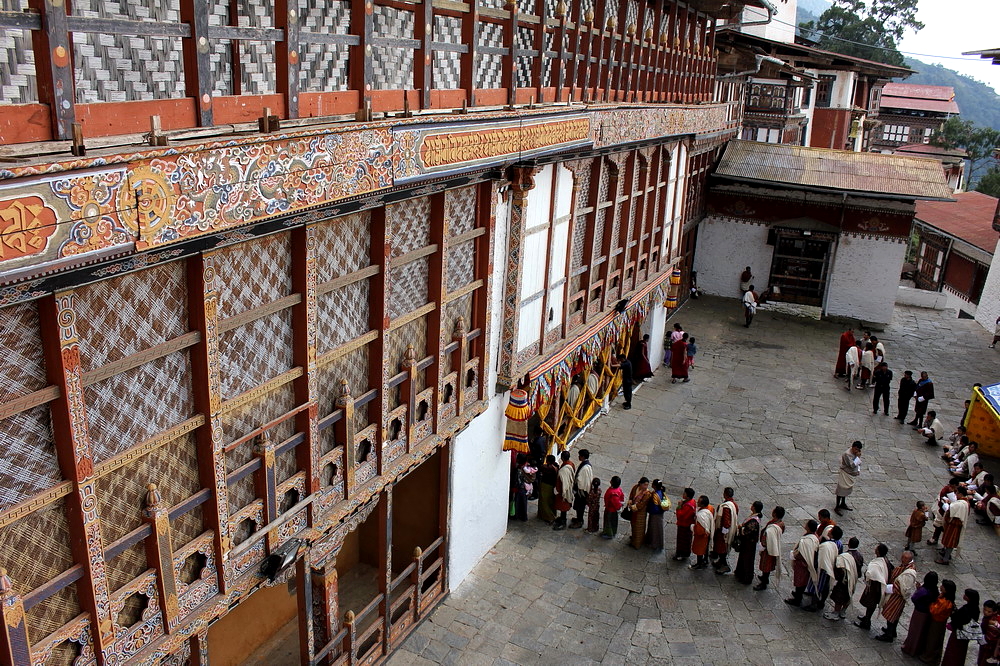
Our journey led us on to Jakar, in Bumthang district. This is the area of Bhutan where the wonderfully colorful fabrics are made, which serve as the basis of the national clothing. We hiked here for two days. On the first day we visited three local temples: Jambay Lhakang, one of the most ancient temples in the country from the 7th Century; the enormous Kurjey Lhakang complex with the imprint of Guru Rinpoche’s body, and finally Tamshing Lhakang.
The following day, a small 15th century monastery called Ngang Lhakang was our destination. The highlight was not the monastery but the walk itself: on a relatively flat ground, through charming villages, in perfect weather. Wherever we went, we met joyful, smiling locals. It’s not by chance that Bhutan is said to be one of the happiest countries in the world.
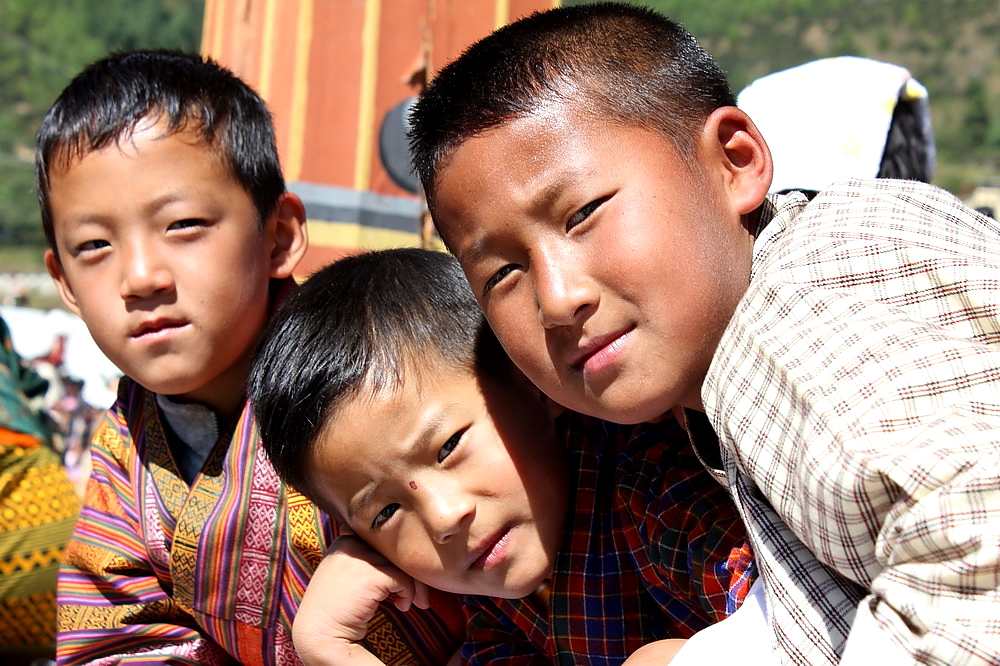
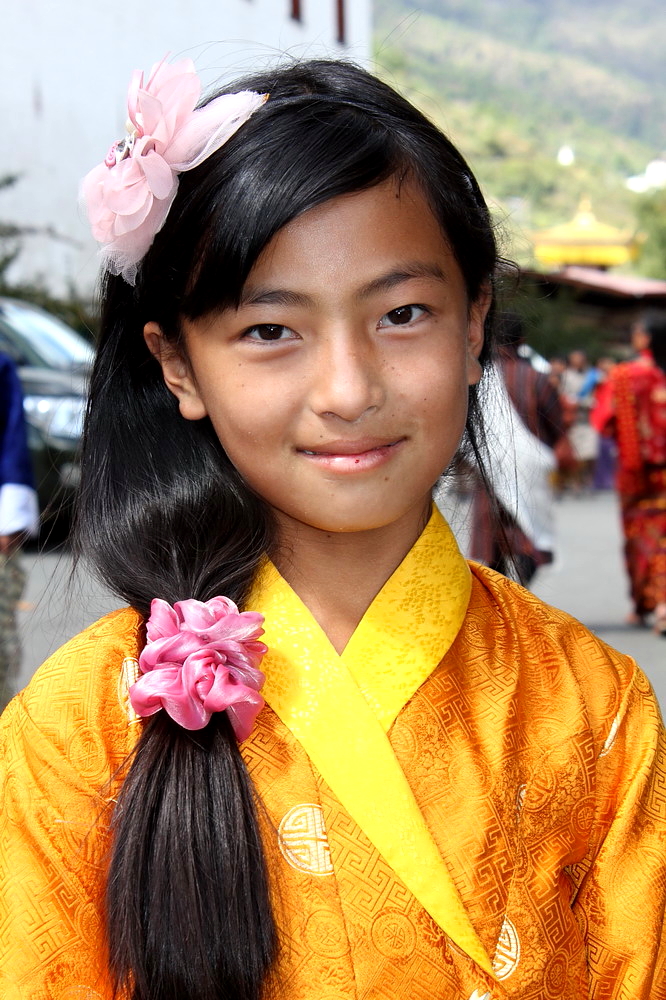
Royal wedding
In the evening in our hotel, we were stuck in front of the TV sets watching the young King’s wedding to his beautiful princess. The country’s current, fifth monarch is a big fan of basketball and Elvis. The incredibly popular Jigme Khesar Namgyel Wangchuck, had announced at the opening session of the Parliamentary year, that he was about to get married. The audience at the Parliament – according to local customs – did not burst out in applause, but quietly acknowledged the news. After that of course everybody congratulated the King.
The same restrained attitude is typical of the locals too. When I asked our local Guide how the King got to know his wife, he looked at me in surprise: it is not his business to know. For the Bhutanese people, all that is important is that the King is getting married, and everybody is happy about it because they love him, and this way they can be sure his dynasty will continue. The King also announced that he was going to be a monogamous husband – unlike his father who married four women, interestingly enough all sisters.
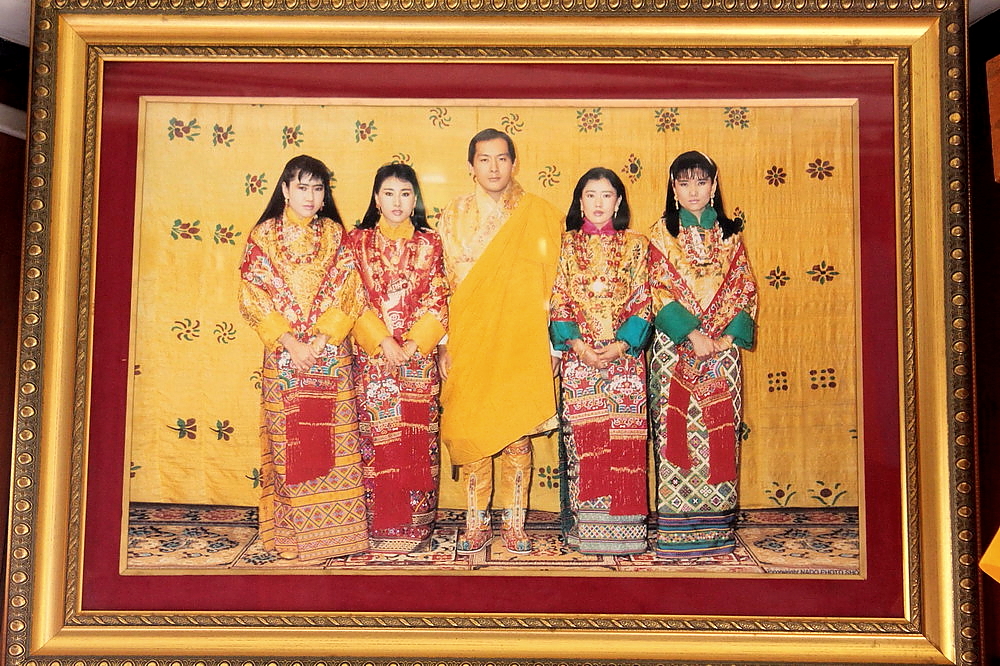
The Queen-to-be is 21 year-old Jetsun Pema, the daughter of a pilot, who has just finished her studies in Oxford. The King, during a country wide tour, proudly introduced his woman-of-choice to his people. Announcing his wedding plans, he also told his people that he would have a modest celebration – on the one hand, due to Bhutan’s limited resources, on the other hand, because he viewed it as an intimate family event. As a result, no other Kings, politicians, or celebrities were invited. The date of the wedding was determined by astrologers, who thoroughly analyzed the couple’s zodiac signs and found them to be a perfect match.
In the country, there was little fanfare around the wedding, unlike other royal weddings. There were no mugs or T-shirts made with the royal couple’s picture on them – only a badge, worn by practically everybody, including us. The shops and hotels wished happiness to the newlyweds with signs, and the good wishes of the Bhutanese people were broadcast continuously on TV.
The ceremony was held in the ancient capital, Punakha, in the recently wonderfully renovated fortress. The building was decorated with colorful flags and red carpets.
The young Prince is rather easy-going. In the evenings he likes to ride his bike around the capital. He was pretty laid back at his wedding as well. During the whole ceremony he behaved with ease, respectfully holding hands and calming his seemingly nervous sweetheart with silent words.
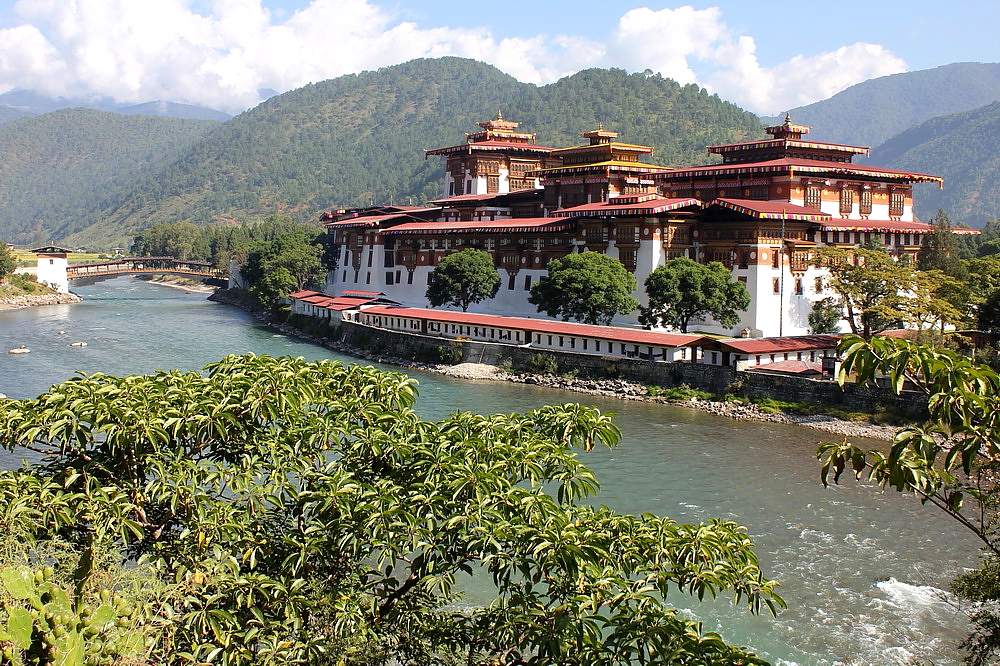
The couple travelled to the capital the next day. In theory it only takes three hours and they left early in the morning, yet they only arrived at their Palace after 11pm. Along the road the locals (and tourists) stood in line silently to congratulate the king. He stopped everywhere, got out of his car and thanked people for their wishes – many of them had walked long hours to see him, and there were plenty who bought new clothes and boots for the big event. On the last section leading to the capital, there was such a thick crowd that there was no point in him getting back into his car, so the couple travelled the last 15 kilometers on foot. We watched it on TV, and it was touching to see even on screen, how the King talked effortlessly to his people and how he threw kisses to the children.
Walking through the country is not new to the King, since he had earlier walked across almost the whole country and met a great deal of people in person. Most people we talked to in Bhutan had already seen the King, with many also having talked to him. A reporter also asked the young couple about the possibility of a honeymoon abroad. “We are travelling instead around our own country, to say thanks to the people for all their wishes” was their polite answer.
On the third day, the Royal couple had a grand celebration in the capital’s huge stadium, which anybody could enter free of charge. The best moment here was when the King asked the audience if he should kiss his bride. After the encouraging cheers, the first public royal kiss happened – to the great delight of the people.
The next day the Royal couple visited a Hindu temple and got married again according to that religion, in honor of Bhutan’s 20 per cent Hindu minority. The King posted photos of this and other important moments of the wedding on his Facebook timeline.
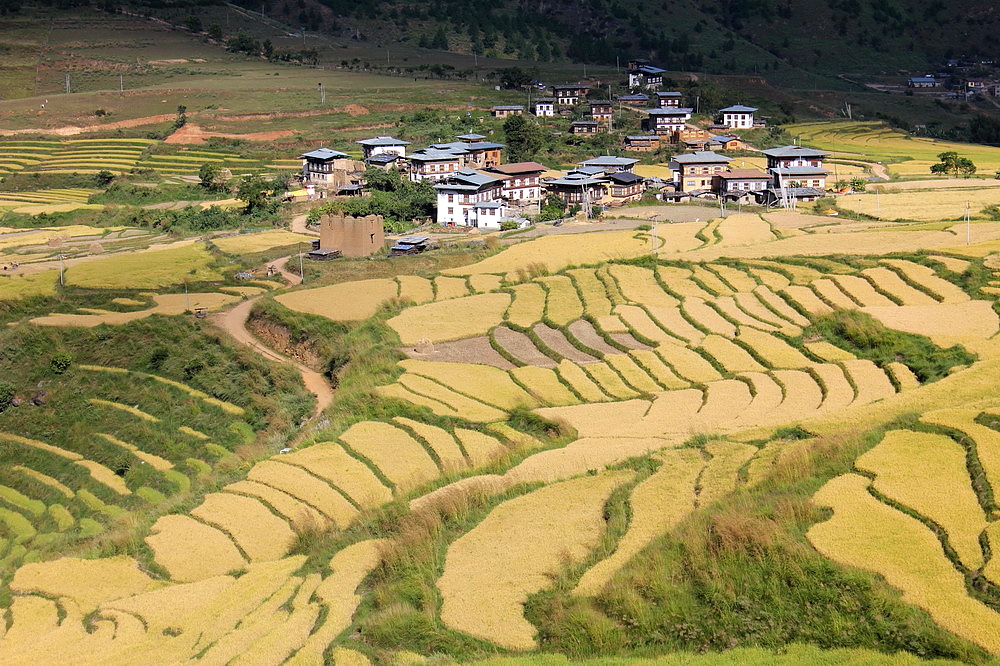
Bats in the room
On the way back to the capital, we planned to stay and explore Gangtey Valley. Accommodation is rather limited in this part of Bhutan. There are only two hotels and those who do not get a room here, get accommodation with local families or in tents. At first, it seemed quaint to sleep in a nice, painted house, but as it got chillier, we sat shivering and humble-mouthed next to the stove in the kitchen, not able to imagine how we were going to sleep in that cold.
Later on we went up to the bedrooms, but soon screaming broke the silence when three bats started to circle around one of the bedrooms. The English travel companions in our group immediately called the travel agency and demanded sudden action, claiming they were not willing to sleep there. With no other solution in town, we left late that night for the 3 hour drive to Punakha and the closest vacant hotel. Once there, in my room, I spotted a huge spider but tired as hell I put up with his company – better than bats any time!
Due to this small incident, we sadly failed to explore Gangtey Valley. There was no sense going back there in the morning. However, this way we could at least visit Punakha monastery, which we had to skip a few days earlier because of the wedding preparations. It felt special to walk along the same red carpet, where the Royal couple had walked just two days before. Near the monastery you can find the country’s longest suspension bridge, which we also couldn’t miss.
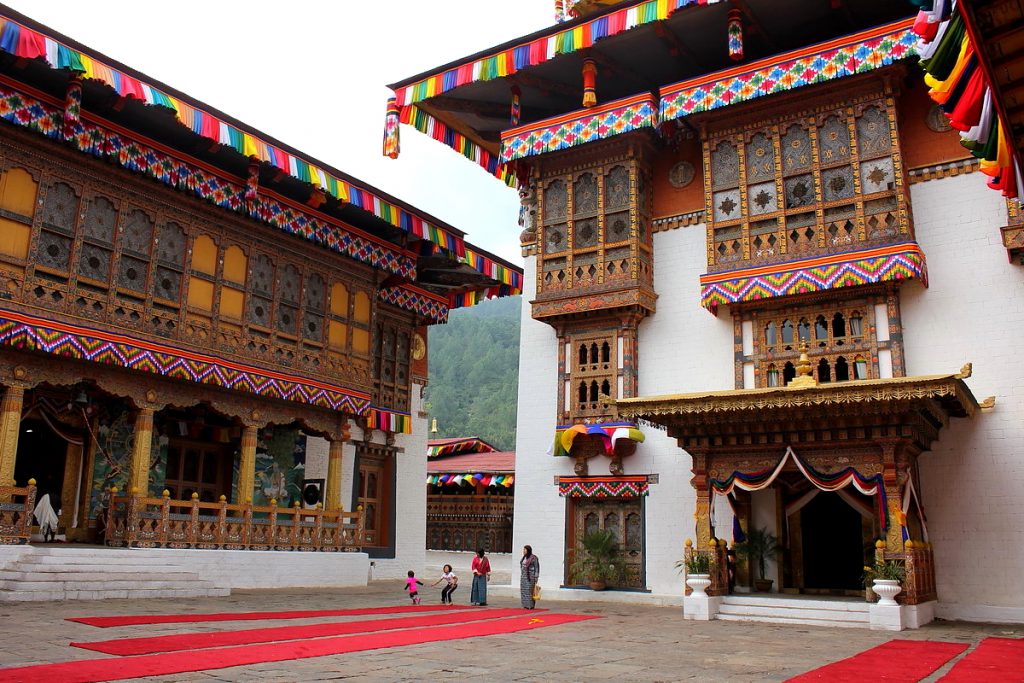
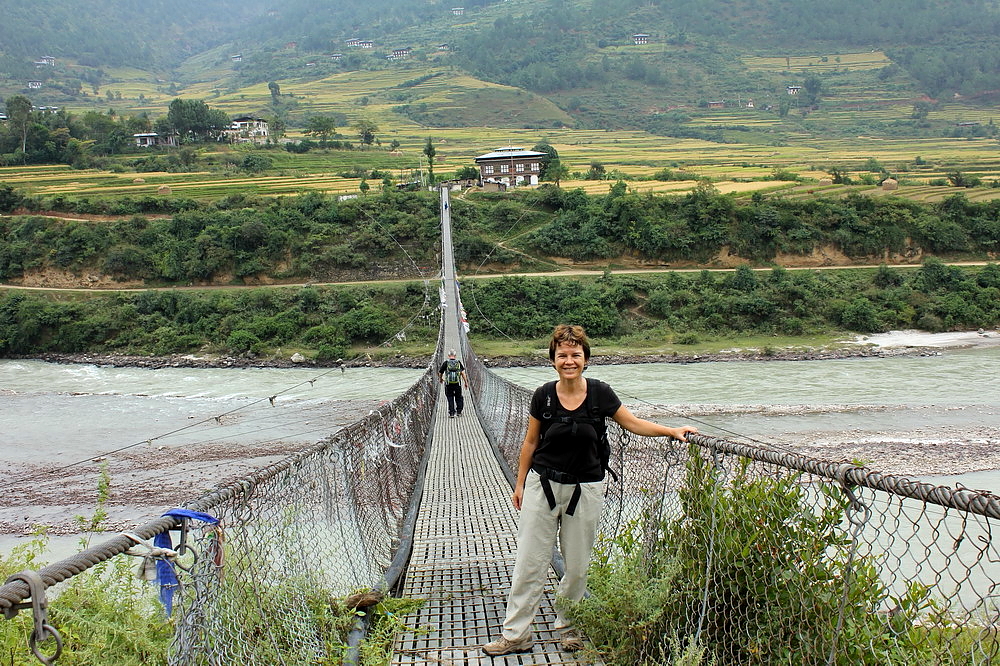
We then drove back to the capital and visited Changangkha Temple, where babies have been brought to be blessed for centuries. On the way to our hotel we ran into the King – he was just driving away in front of us in a remarkably simple jeep.
There was just one last trek left, to probably the country’s most famous monastery: Tiger’s Nest, a real symbol of Bhutan. Legend says that Padma Sambhava, an Indian guru flew here on the back of a tiger from Tibet, to spread Buddhism in Bhutan after fighting with five demons. The parking lot is a two and a half hour bus ride from the capital city, and it takes another two and a half hours of walking to go up there. When we looked up to the mountain, it seemed a mission impossible to reach the temple.
The trek is only 4 kilometers long, but it starts with a 400 meters uphill walk, and when it seems that the monastery is within easy reach, it turns out it’s actually on the neighboring mountain: you then have to descend the gorge, before climbing up again on the other side, this time on stairs.
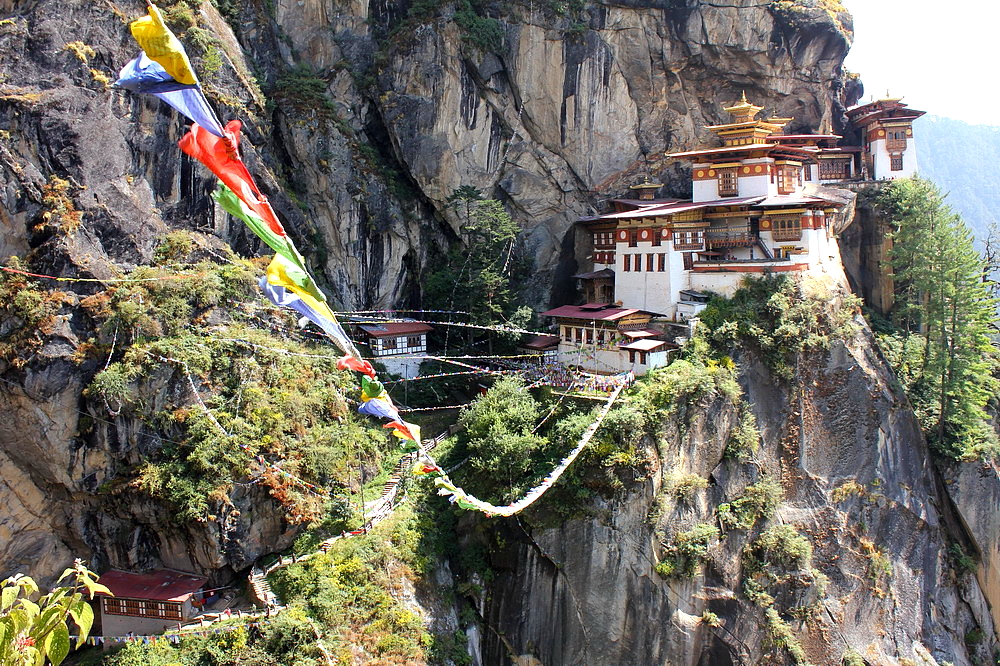
The Bhutan tour came to an end in Paro, where another culinary surprise was waiting. This time there was not Tibi chocolate on the shelves, but Hungarian goulash on the buffet table.
I believe it was well worth paying the extra fee to travel around Bhutan. We got an insight into an absolutely unique world – where totally different values than here in the western hemisphere motivate people. The experience completely recharged my batteries, and since my journey to Bhutan I think a bit differently about wealth. Bhutan is one of the few countries that has avoided globalization, and where – considering only very few people travel here – we can not only witness change, but be active participants as well.
